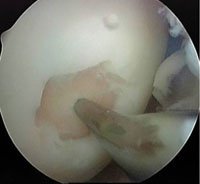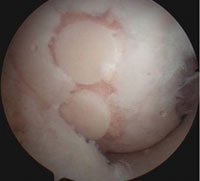Varied success rates seen with articular cartilage knee surgeries
Click Here to Manage Email Alerts
From marrow stimulation procedures to matrix-induced autologous chondrocyte implantation, various articular cartilage therapies exist for orthopedic surgeons treating knee defects and new techniques involving stem cells may be on the horizon.
“These are very different treatment decisions,” Orthopedics Today Editorial Board member, Jack M. Bert, MD, said. He noted that surgeons should choose treatments based on patient age and activity level, lesion size and severity, and the desired type of restored cartilage.
Debridement, viscosupplementation
“Debridement is still an appropriate viable option in the patient with an articular cartilage lesion that does not respond to conservative care with mechanical symptoms,” Bert said during a presentation at Orthopedics Today Hawaii 2011. The procedure is indicated for patients with meniscal tears or loose bodies and may postpone the need for total knee arthroplasty. He also noted that the success rate for the procedure varies between 50% to 80% in the literature.
Bert said there is “significant justification” for using viscosupplementation in cases and noted that several top-level studies showed decreased pain and crepitus with these injections. He cited a “game changing” study by Stephen Hall, MD, which showed cartilage preservation in patients who received hyaluronic acid injections.
Marrow stimulation techniques
While marrow stimulation procedures such as abrasion arthroplasty and microfracture are reasonable, Bert said surgeons should be aware that normal cartilage will not be regenerated.
“This technique is generally effective for about 2 years, but then the failure rates dramatically increase between 2 and 5 years postoperatively,” he told Orthopedics Today.
|
|
Images: Bert JM |
He noted that autologous chondrocyte implantation (ACI) renders hyaline-like cartilage, but is an expensive and time-consuming procedure. However, he noted that recent research by investigators such as Philipp Niemeyer, MD, show that the procedure may be beneficial for larger lesions, and may produce less subchondral bone damage than microfracture.
“ACI, [matrix-induced] ACI and microfracture have the same results at 5 years and clearly, the indication for ACI is in larger defects no matter how you compare the literature,” Bert said.
OATS, osteochondral allograft transplantation
Osteochondral autograft transfer system (OATS) will produce hyaline cartilage, except at the perimeter of the defect.
“Even if you do a perfect job with multiple OATs transplantations, you may still leave with 40% of the surface with just raw bone that you’re going to have to microfracture and get fibrocartilage,” Bert said. “Theoretically, this should yield the best results long-term since the biopsy studies do confirm normal hyaline cartilage.”
Osteochondral allograft transplantation is suitable for massive defects, but can leave suboptimal results at the perimeter of the defect. Bert also noted the failure rates of the procedure as a significant concern.
New routes for regeneration
“Biologics and scaffolds, these show promise and are being done off-label in non-weightbearing surfaces to allow for ingrowth of hyaline cartilage into the matrix material onto the adjacent hyaline cartilage,” Bert said. He cited research spearheaded by Alberto Gobbi, MD, that uses scaffolds of plugs comprised of autologous chondrocytes.
“The researchers claim that after 2 years, new hyaline-like cartilage appears on the surface of the bone,” Bert said.
Evolving arthroscopic treatments may also hold potential. “Removing red blood cells and plasma with a cell separator, you can get a concentrate containing nucleated cells and these are basically stem cells: monocytes, lymphocytes and other bone marrow resident cells,” Bert said. He cited research by Roberto Buda, MD, which investigated the impact of using bone marrow concentrate loaded on membranes in patients with grade 4 defects.
“Early results are showing type 2 proteogylcan with safranin O staining,” Bert said. “This may just be the next wave of treatment.” — by Bob Kronemyer and Gina Brockenbrough, MA
References:
- Bert JM. Articular cartilage surgery. Presented at Orthopedics Today Hawaii 2011. Jan 16-19. Koloa, Hawaii.
- Buda R, Vannini F, Cavallo M, et al. Osteochondral lesions of the knee: A new one-step repair technique with bone-marrow-derived cells. J Bone Joint Surg (Am). 2010;92(Supplement 2):2-11.
- Hall S, Wang Y, Hanna F, et al. Effects of HYLAN G-F 20 [Synvisc] supplementation on cartilage preservation in osteoarthritis of the knee: A two-year, single-blind clinical trial. Paper SS-A. Presented at the 2010 Annual Meeting of the Arthroscopy Association of North America. May 20-23. Hollywood, Fla.
- Jack M. Bert, MD, can be reached at Summit Orthopedics, 17 Exchange St. West, 307 Gallery Medical Building, Saint Paul, MN 55102; 651-223-9204; email: bertx001@tc.umn.edu.
- Disclosure: Bert is a paid consultant to Genzyme.



